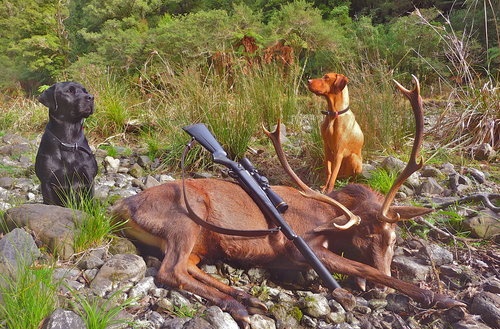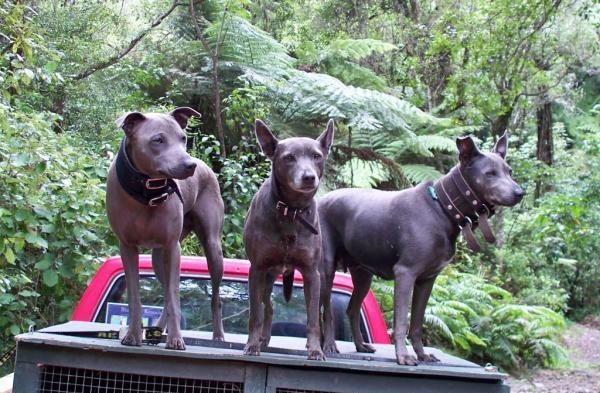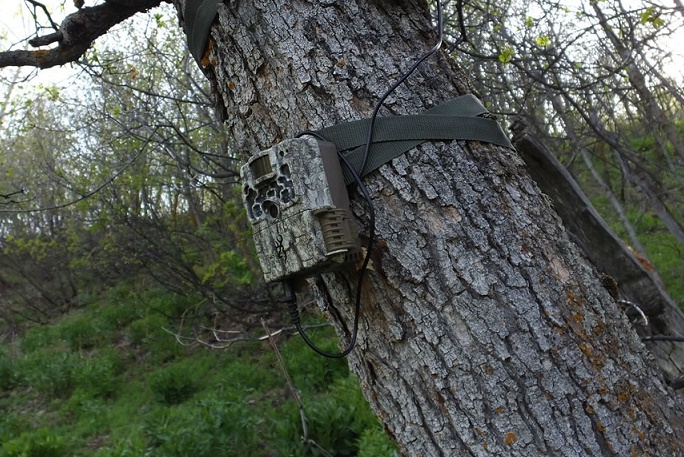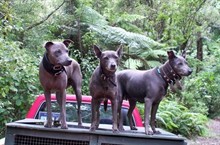Hunting Deer with Dogs Effectively
It’s no secret that “Man’s Best Friend” is also one of his best partners when going out hunting. Their focused nature and advanced sense of smell  make them ideal trackers when going out for prize bucks. But with many places and some states outright banning the use of dogs in deer hunting, it is becoming surprisingly hard to find good tips and tricks for this once-noble sport.
make them ideal trackers when going out for prize bucks. But with many places and some states outright banning the use of dogs in deer hunting, it is becoming surprisingly hard to find good tips and tricks for this once-noble sport.
Let’s be clear here, though, if you live in a place that allows for dogs to accompany you on your hunts, you should know that a deer-trailing canine is just as good as any deer trail camera (though that’s not to understate how well the both of them work together).
If you’ve been wondering how to best utilize your dog, or maybe a dog you haven’t gotten yet, for hunting deer, look no further. Here, I’ve listed a few tips and tricks that have worked for me and my dog, and I’m sure you’ll be able to work some of these in your hunts as well.
Starting with a Good Breed
Perhaps just as important as using a dog well for hunting is having a dog that’s well-built for hunting in the first place. Traditionally, at least since colonial times, the American Foxhound has been the de facto deer hunting dog, as its a breed that’s specifically engineered for trailing prey out in the wilderness. The  American Foxhound has an excellent nose for tracking wounded prey, as well as the energy and “go-getter” personality to keep them motivated on long and
American Foxhound has an excellent nose for tracking wounded prey, as well as the energy and “go-getter” personality to keep them motivated on long and  arduous treks. Their stature, leg muscles, and body shape also make them a swift-moving breed that can clear brush and uneven ground just as quickly as any deer. While not exactly the large and intimidating type, American Foxhounds are by nature expert hunters, and are invaluable even now as hunting dogs.
arduous treks. Their stature, leg muscles, and body shape also make them a swift-moving breed that can clear brush and uneven ground just as quickly as any deer. While not exactly the large and intimidating type, American Foxhounds are by nature expert hunters, and are invaluable even now as hunting dogs.
Another good breed for deer hunting is the Blue Lacy. Said to have been registered as a breed in 2001 by the Texas Senate, the Blue Lacy game dog is friendly, energetic, and always determined to get the job done. They’re also notable for their unerring bravery, as they will fearlessly throw themselves against prey of any size, in weather of any severity. Since 2005, they have been recognized as the state dog of Texas, and with their natural work ethic. friendly nature, and boundless energy, it’s hard not to see why they’ve been chosen to represent the state.
Of course, no hunting dog guide should go without some mention to the Golden Retriever, arguably the most popular of dog breeds, not to mention an excellent hunter as well. Their primary strengths are in their steadfast devotion to both their masters and their tracking, as well as their peerless intelligence; Golden Retrievers not only work hard, but they work smart, and they have the power and energy to perform excellently against even the most spirited of deer.
Raise ’em Right
It’s usually best to start out with a puppy if you don’t already have a hunting dog on hand. Buying dogs already trained for hunting is possible, but it’s really not worth it when the dog isn’t bonded with you. Having them trained at a young age, preferably after basic obedience training, will help turn your spunky young pup into a lifelong hunting partner.
One of the first things you’ll want to do, even before any sort of formal training, is expose the young puppy to open water as much as possible. This especially helps with training up a dog to hunt waterfowl, but it’s also immensely helpful for deer hunting as well. Having your dog accustomed to, and comfortable with, bodies of water will help it track and chase deer across rivers and streams.
Another important thing to do is to take your dog to “hunts,” even if they’re not trained enough to be an actual participant in it. Ideally, you’ll want to take your dog out to hunting-like situations, with real guns and real hunting grounds. You’ll want your dog accustomed to the sights and sounds of hunting before you start training them in actual hunts.
Finally, when you think your dog is ready to start helping you on your hunts, have them go for smaller game at first. Rabbits, squirrels, and the like are good for getting them accustomed to hunting for larger game. It’s also important to have them accustomed to the scent of deer, preferably with deer-scented dummies, so that they’ll know what to go after when the time comes.
Scout Them Out, Track Them Down
While using dogs to hunt deer is illegal in many parts of the U.S., it’s still possible to have your dogs help out on your hunts in certain contexts. Most notably, in many places where dog deer hunting is banned, it’s still possible to have your dog help you track wounded deer that you’ve found and shot. It’s actually the most common use for dogs on the hunting trail, and dogs tend to be absolutely great at tracking down wounded prey.
One of the most useful things to have to train up your dog for deer tracking is a sample of deer blood, perhaps a small frozen packet of blood. This can be mixed with water and spread across in a trail to simulate a wounded deer trail. Placing rewards at the end of this trail, first dog treats and later actual deer meat, will help familiarize your dog to the scent and taste of deer blood, allowing him or her to become an effective deer tracker.
Hybrid Tactics: Dogs and Cams
In this day and age, we have a lot of features and advantages at our fingertips to make hunting more efficient and effective. So there’s hardly any  reason not to combine some of what’s worked in the past, namely dogs, with what’s working nowadays, trail cameras specifically.
reason not to combine some of what’s worked in the past, namely dogs, with what’s working nowadays, trail cameras specifically.
Trail cameras are best for scouting out deer before a hunt, as they will usually let you know where they are, where they tend to move, and at what times they’re active. Using a camera will help you track down your prey and, hopefully, get a good shot in. Once you’ve done that, your dog can help with the rest. While cameras can provide high-definition pictures, they’re stationary, and can’t follow deer. Dogs can, however, and will relentlessly chase down your prey if you set them on the right path., which you can usually triangulate with the help of trail cameras. In this way, dogs and trail cameras work quite well with each other.
Conclusion
Hopefully, some of these tips will help you become a better hunter with your dog, or at least get you started on training up a deer dog. You now know what kinds of dog are good with deer hunting, how to train up a dog for deer hunting, how to get them adjusted to tracking down wounded deer, and how to utilize them with trail cameras. Above all else, keep your hunting dogs active. It will help them become an active part of your hunt!
Hunter Dunbar
At HuntEmUp.com, we know sporting dogs. From the time they’re a puppy, through their senior years, we’ll keep you informed on the latest news and information. For more information on Training, Preparing and Caring for your Dogs, read our Hunting and Sporting Dog blog.
Join Our HuntEmUp.com Customer Club Today!
Join Our Customer Club and be entered in our Monthly Giveaway and a chance to Win products and more!
Join for FREE Today – Click Below to Get Started!







